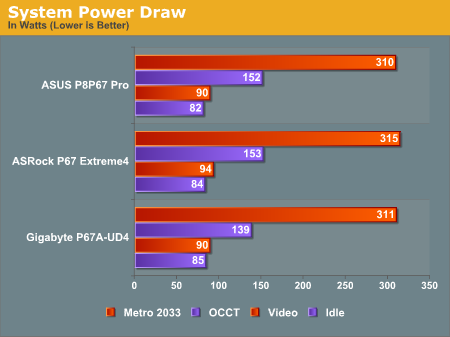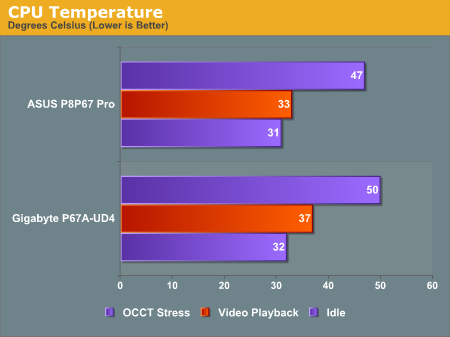The Battle of the P67 Boards - ASUS vs. Gigabyte at $190
by Ian Cutress on January 20, 2011 4:15 PM EST- Posted in
- Motherboards
- Gigabyte
- Asus
- P67
| Test Setup | |
| Processor |
Intel i5-2500K ES – 3.3 GHz (3.7 GHz Turbo) 4 Cores, 4 Threads, 6MB L3 |
| Motherboards |
ASUS P8P67 Pro Gigabyte P67A-UD4 |
| Cooling | Corsair H50-1 Water Cooler |
| Power Supply | Enermax Modu87+ 600W 80PLUS |
| Memory |
Patriot Viper Xtreme DDR3-2000 9-10-9-27 2x4GB Kit, 1.65V Patriot Viper Xtreme DDR3-2133 9-11-9-27 2x2GB Kit, 1.65V Corsair Vengeance DDR3-1600 9-9-9-24 2x4GB Kit, 1.50V |
| Memory Settings | Patriot Viper Xtreme DDR3-1333 9-9-9-24 2x2GB |
| Video Cards | XFX HD 5850 1GB |
| Video Drivers | Catalyst 10.12 |
| Hard Drive | Intel X25-M 80GB SSD Gen2 |
| Optical Drives | LG GH22NS50 |
| Case | Open Test Bed – CoolerMaster Lab V1.0 |
| Operating System | Windows 7 64-bit |
| USB 2/3 Testing | Patriot 64GB SuperSonic USB 3.0 |
Power Consumption and CPU Temperature
Power consumption was tested on the default system as a whole with a wall meter connected to the power supply, using a dual GPU configuration. This method allows us to compare the power management of the UEFI/BIOS and the board to supply components with power under load, and includes typical PSU losses due to efficiency. These are the real world values that consumers may expect from a typical system (minus the monitor) using these motherboards.


Neither system does too badly in power consumption readings, but the Gigabyte is behind on temperature deltas. This could easily be attributed to the mounting - while every attempt is made to repeat the mounting technique, there is always a range of statistical variation, so the 2-4ºC difference is nothing obvious to be concerned about.










137 Comments
View All Comments
Tommieemict - Wednesday, June 10, 2020 - link
nude teen sisters on periods https://teenwebcams00.uno">teenwebcams00.uno chubby indian teen nude.CarsonJoine - Wednesday, June 10, 2020 - link
naked mature selfie tits https://maturewebcams00.space">mature wife fuck tube mature fucked at massage.milf sucking teen cock https://milfwebcams00.casa">milfwebcams00.casa homies fuck white milf dp.
amateur big tit teen casting https://amateurwebcams00.xyz">amateurwebcams00.xyz amateur good looking black couple fuck.
2018 black ameature porn in hd https://blackwebcams00.icu">blackwebcams00 black amateur guy fucking amateur mexican girl.
sexy mature latina porn https://maturewebcams00.space">maturewebcams00.space thick huge tit mature pics.
JamesSag - Thursday, June 11, 2020 - link
lesbian initiation rite video https://lesbianwebcams01.fun">lesbianwebcams01.fun vintage lesbian porn gifs.moms gone black porn https://blackwebcams00.icu">pimp wife black men porn lets fuck black pussy couple porn.
gay black porn inetrracil threesomes https://blackwebcams00.icu">blackwebcams00 black nude model art.
dick an jane mature couple tumblr https://maturewebcams00.space">maturewebcams00.space gay mature tumblr masturbation.
two teens caught in pool fuck https://teenwebcams00.uno">petite teen creampie porn curvy teen girl nude strip.
Michaelsok - Friday, June 12, 2020 - link
video asian milf seduces me sex https://asianwebcams00.host">indian boss kissing and sex with receptionist fuck unconscious japanese business woman video.BrianSat - Friday, June 12, 2020 - link
sexy lesbian mom footrub https://lesbianwebcams00.fun">lesbianwebcams00.fun lesbian bondage training porn.hd milf ffm porn https://milfwebcams00.casa">hot thick milf pinterest perfect boobs milf fuck.
fucking a drunk milf https://milfwebcams00.club">milf boss fucks male employee milf monster cock creampie.
Mature blonde gang-raped on a couch https://maturewebcams00.club">maturewebcams00 young old russian mature sex.
white ass black dick https://blackwebcams00.pw">blackwebcams00.pw sexy ebony lesbian threesome.
Steveunfah - Sunday, June 14, 2020 - link
indian wife nude orgy outdoor https://asianwebcams00.host">massive asian tits tumblr asian teen fucks boyfriends friend.mary jane scott college girls nude https://collegewebcams00.store">naked college girl sex college girl rides cock gif.
chubby anal bbc amateur https://amateurwebcams00.monster">amateurwebcams00 amateur milf riding big cock creampie.
milf big ass anal https://milfwebcams00.casa">milf wants young cock gif milf next door naked.
asian fucking for a long time https://asianwebcams00.host">hot naked japanese women thai lan hd sex.
JamesSmant - Monday, June 15, 2020 - link
big hairy college cock https://collegewebcams00.store">collegewebcams00.store college girl masturbation color hidden.